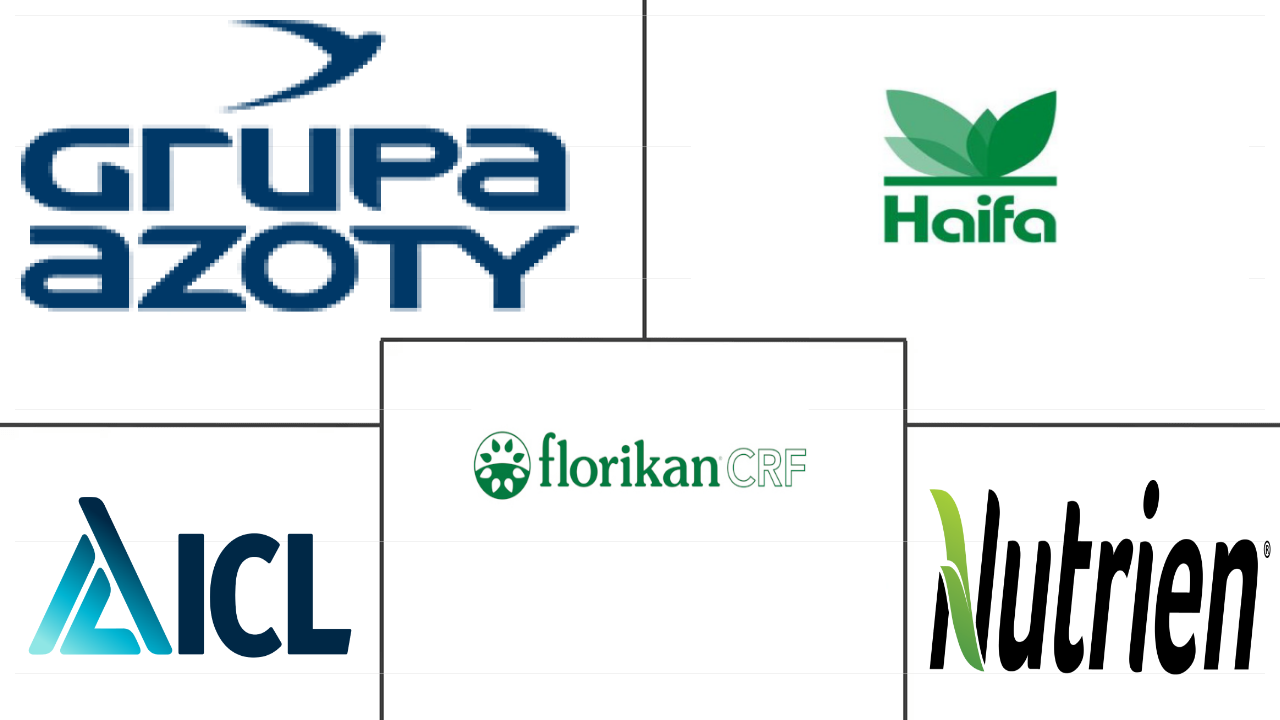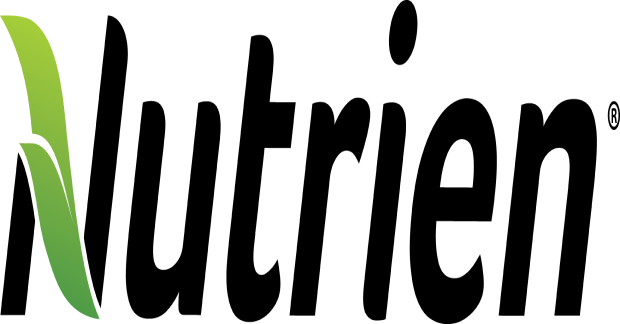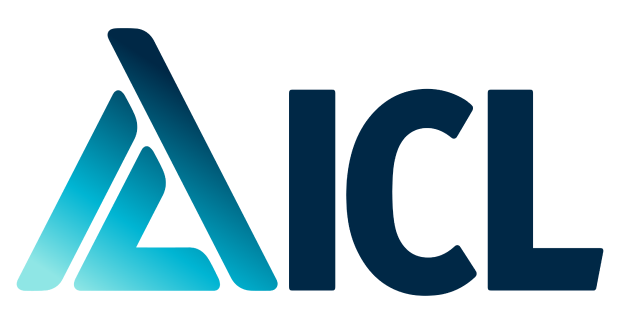Market Size of united states controlled release fertilizer Industry
| Icons | Lable | Value |
|---|---|---|
|
|
Study Period | 2017 - 2030 |
|
|
Market Size (2024) | USD 408.4 Million |
|
|
Market Size (2030) | USD 651.4 Million |
|
|
Largest Share by Coating Type | Polymer Coated |
|
|
CAGR (2024 - 2030) | 8.09 % |
|
|
Fastest Growing by Coating Type | Polymer Coated |
|
|
Market Concentration | High |
Major Players |
||

|
||
|
*Disclaimer: Major Players sorted in no particular order |
United States Controlled Release Fertilizer Market Analysis
The United States Controlled Release Fertilizer Market size is estimated at 408.4 million USD in 2024, and is expected to reach 651.4 million USD by 2030, growing at a CAGR of 8.09% during the forecast period (2024-2030).
408.4 Million
Market Size in 2024 (USD)
651.4 Million
Market Size in 2030 (USD)
9.29 %
CAGR (2017-2023)
8.09 %
CAGR (2024-2030)
Largest Segment by Type
52.27 %
value share, Straight, 2023
Straight fertilizers are the most consumed fertilizer, as Nitrogen is the most yield-limiting nutrient for crop growth and farmers are highly adapted to its usage.
Largest Segment by Coating Type
76.52 %
value share, Polymer Coated, 2023
Polymer coated urea has ability to readuce leaching and voltalization losses and improve Nitrogen use efficiency which has resulted in higher demand and largest market share.
Largest Segment by Crop Type
87.49 %
value share, Field Crops, 2023
Higher nutrient requirement and growing concerns over nutrient leaching rising the adoption of control released fertilizers in filed crops making them largest crop type.
Leading Market Player 1
58.32 %
market share, Nutrien Ltd., 2022

Nutrien Ltd. acquired Van Horn, Inc. a leading US retailer and agricultural services provider which serve over 5,000 customers in 18 countries to grow their Retail business.
Leading Market Player 2
18.90 %
market share, ICL Group Ltd, 2022

ICL Group Ltd. have different technologies for production of controlled release fertilizers such as Poly-S, Resin and E-Max release technology making it leading market player.
The efficiency of CRFs in reducing nitrogen and phosphorus leaching propels market growth
- The market for controlled-release fertilizers in the United States was valued at USD 428.7 million in 2022. With mounting pressure on the agriculture sector to mitigate environmental repercussions, coupled with the benefits of enhanced nutrient efficiency and precise application, the market value is projected to witness a robust CAGR of 8.0% from 2023 to 2030.
- Controlled-release fertilizers offer a gradual and prolonged nutrient release, ensuring crops receive a consistent supply of vital elements throughout their growth cycle. By curbing nutrient leaching and runoff, these fertilizers play a pivotal role in reducing the environmental impact of field crop agriculture, particularly in addressing concerns about water quality and pollution.
- Field trials have shown that coated controlled-release fertilizers outperform their uncoated counterparts, reducing leaching by 69.0% for nitrogen-based fertilizers and 82.0% for phosphate-based ones. In contrast, uncoated conventional urea can lose up to 40% of its ammonia content through volatilization. Extensive testing over multiple years has consistently demonstrated that coated urea can slash ammonia losses by a minimum of 95.0%.
- In 2022, polymer coating dominated the United States controlled-release fertilizer market, accounting for 76.4% of the industry. Environmental and cost considerations are driving the demand for polymer-coated controlled-release fertilizers, thanks to the nation's focus on field crop cultivation. The polymer-coated segment is expected to witness a healthy growth rate of 7.7% from 2023 to 2030.
- The United States is witnessing a surge in demand for controlled-release fertilizers, propelled by government regulations aimed at curbing the environmental impact stemming from excessive fertilizer accumulation.
United States Controlled Release Fertilizer Industry Segmentation
Polymer Coated, Polymer-Sulfur Coated, Others are covered as segments by Coating Type. Field Crops, Horticultural Crops, Turf & Ornamental are covered as segments by Crop Type.
- The market for controlled-release fertilizers in the United States was valued at USD 428.7 million in 2022. With mounting pressure on the agriculture sector to mitigate environmental repercussions, coupled with the benefits of enhanced nutrient efficiency and precise application, the market value is projected to witness a robust CAGR of 8.0% from 2023 to 2030.
- Controlled-release fertilizers offer a gradual and prolonged nutrient release, ensuring crops receive a consistent supply of vital elements throughout their growth cycle. By curbing nutrient leaching and runoff, these fertilizers play a pivotal role in reducing the environmental impact of field crop agriculture, particularly in addressing concerns about water quality and pollution.
- Field trials have shown that coated controlled-release fertilizers outperform their uncoated counterparts, reducing leaching by 69.0% for nitrogen-based fertilizers and 82.0% for phosphate-based ones. In contrast, uncoated conventional urea can lose up to 40% of its ammonia content through volatilization. Extensive testing over multiple years has consistently demonstrated that coated urea can slash ammonia losses by a minimum of 95.0%.
- In 2022, polymer coating dominated the United States controlled-release fertilizer market, accounting for 76.4% of the industry. Environmental and cost considerations are driving the demand for polymer-coated controlled-release fertilizers, thanks to the nation's focus on field crop cultivation. The polymer-coated segment is expected to witness a healthy growth rate of 7.7% from 2023 to 2030.
- The United States is witnessing a surge in demand for controlled-release fertilizers, propelled by government regulations aimed at curbing the environmental impact stemming from excessive fertilizer accumulation.
| Coating Type | |
| Polymer Coated | |
| Polymer-Sulfur Coated | |
| Others |
| Crop Type | |
| Field Crops | |
| Horticultural Crops | |
| Turf & Ornamental |
United States Controlled Release Fertilizer Market Size Summary
The United States controlled release fertilizer market is experiencing significant growth, driven by the need for sustainable agricultural practices and the efficient use of nutrients. These fertilizers are designed to release nutrients gradually, ensuring a steady supply to crops and minimizing environmental impact by reducing nutrient leaching and runoff. This is particularly important in addressing water quality concerns. The market is characterized by a strong demand for polymer-coated fertilizers, which dominate the industry due to their effectiveness and cost considerations. The focus on enhancing agricultural productivity, especially in key crop areas like the Corn Belt, is further propelling the market's expansion.
The market landscape is fairly consolidated, with major players like Grupa Azoty S.A. (Compo Expert), Haifa Group, ICL Group Ltd, New Mountain Capital (Florikan), and Nutrien Ltd. leading the industry. These companies are actively innovating and expanding their product offerings to meet the growing demand for controlled release fertilizers. The United States' agricultural sector, with its significant reliance on primary nutrients such as nitrogen, potassium, and phosphorus, is poised for continued growth as these fertilizers help optimize crop yields and reduce cultivation costs. Government regulations and support are also playing a crucial role in fostering market growth, as they encourage the adoption of environmentally friendly agricultural inputs.
United States Controlled Release Fertilizer Market Size - Table of Contents
-
1. MARKET SEGMENTATION (includes market size in Value in USD and Volume, Forecasts up to 2030 and analysis of growth prospects)
-
1.1 Coating Type
-
1.1.1 Polymer Coated
-
1.1.2 Polymer-Sulfur Coated
-
1.1.3 Others
-
-
1.2 Crop Type
-
1.2.1 Field Crops
-
1.2.2 Horticultural Crops
-
1.2.3 Turf & Ornamental
-
-
United States Controlled Release Fertilizer Market Size FAQs
How big is the United States Controlled Release Fertilizer Market?
The United States Controlled Release Fertilizer Market size is expected to reach USD 408.41 million in 2024 and grow at a CAGR of 8.09% to reach USD 651.35 million by 2030.
What is the current United States Controlled Release Fertilizer Market size?
In 2024, the United States Controlled Release Fertilizer Market size is expected to reach USD 408.41 million.

